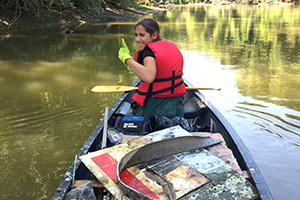As we move through a second year defined by the COVID-19 pandemic, we are all learning to do things differently. What once seemed like a temporary condition now seems more like a permanent shift in our hearts, minds, homes, and families, as well as in the way that we work. As a mission-driven organization, HRWC has learned a lot about ourselves this past year. One of the silver linings was the ingenuity and perseverance I saw in our team. We found new ways to get work done and to engage with you all. The solutions were ever-evolving as no two months of this pandemic have been the same. But we have landed on several new ways of implementing our work, and I think they will stick with us through the full arc of this story and beyond.
As many of you know, HRWC expands our impact by working with many of you. As valued volunteers that collect data from the river to guide restoration, investigators that report issues you see in the watershed, residents who change your behaviors in ways that lessen your impact, and advocates that push local and state leaders to enact policies and programs that keep our river healthy and drinking water clean—we appreciate you! Yet one of the most difficult things to accomplish during this pandemic was to engage with you. And in a zoom-weary society, we sought alternative ways to keep us all working for the river.
We have cooked up content and programs that allow our greatest asset—our community—to continue working for the river because together we make a difference!
#huronriverdiy

With more people engaging in outdoor recreation, a downside is that there is more trash than ever. Do-it-yourself river cleanups can be done safely with your household or your pandemic pod—and help to lessen the impacts of river recreation. Visit our DIY Cleanup Page to learn more, but don’t stop there. Let’s take this viral. Share pictures of your adventure and tag it with #HuronRiverDIY encouraging your friends to do the same.
Field Day Fridays on Instagram and Facebook
HRWC monitoring teams have found creative ways to continue our summer field work. This is the critical work that gets staff, volunteers, and interns to locations throughout the watershed to identify issues like erosion, invasive species, illicit discharges, high phosphorus, and harmful bacteria levels. While we have had to scale back these efforts to some degree, we continue to keep our eyes on the river. We want to show you what we do and answer some of your most commonly asked questions. All summer long, keep an eye on our social media channels (Facebook and Instagram) for a series of staff-produced short videos from the field. Our team will answer questions like “Is this an algal bloom, and is it toxic?”, “Is that foam bad?” and “Can I eat the fish?” and share facts about our work and the river. Watch HRWC’s Field Day Fridays video shorts on YouTube!
Change Makers Workshops
HRWC will host several Change Makers workshops this year. Change Makers gives you the information you need to be a water advocate at the local level. Whether you are a concerned citizen who wants to promote river-friendly development in your community, considering running for office, or are a current elected official, Change Makers helps you learn to navigate local governments’ decision-making processes to encourage river-friendly policies that protect clean water.
Welcome Back, Suds on the River
Finally, we are planning to meet again, thursday, September 9, on the banks of the Huron River, for our annual Suds on the River fundraiser. We will follow recommendations to keep us safe and compliant with the current health guidelines, and we are hopeful that we will see many of you under the big white tent (which might be even bigger), sharing a taste from our local breweries and a bite from our area restaurants, celebrating the river we love and all that we are able to accomplish together. I hope to see you there.
This blog post was originally published June 1st in the Huron River Report, Summer 2021.



